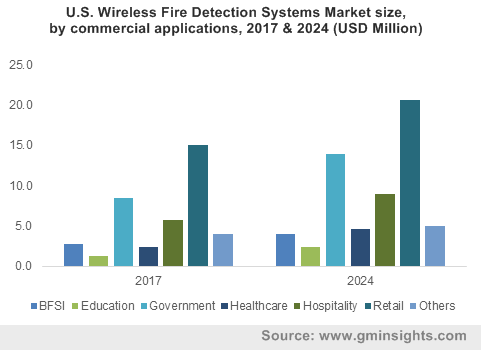Wireless fire detection systems market to be governed by a stringent regulatory framework over 2018-2024, smart city development initiatives to contribute toward the industry expansion
Publisher : Fractovia | Published Date : April 2018Request Sample
Thriving in an era dominated by smart variables, wireless fire detection systems market size has observed a commendable rise lately, owing to the adoption of smart technologies in building management. In the coming years, the deployment of high-grade technologies such as sensors, IoT, and other wireless embedded systems may increase tremendously, massively augmenting product demand. On these grounds, technology providers have been working to develop advanced systems so as to ensure safety and security in new construction projects, that would help augment wireless fire detection systems industry.
U.S. Wireless Fire Detection Systems Market size, by commercial applications, 2017 & 2024 (USD Million)

Considering that this vertical revolves around the provision of a safe living environment, it is rather overt that regulatory bodies have a major role to play in its upliftment. In accordance with the same, a set of codes and standards with regards to fire safety has already been formulated by the authorized organizations. These standards are periodically upgraded with respect to the changing scenario of infrastructure development – say for instance, the development of smart homes and cities now demands the enforcement of better fire safety codes.
Indeed, the implementation of smart cities has now been increasing at a commendable pace, especially with regional governments undertaking numerous initiatives to develop smart city programs and other advanced construction and infrastructure development projects. What’s more, governmental bodies have also recognized the importance of maintaining heritage buildings, owing to which they have been providing considerable support, both on moralistic and monetary grounds, to deploy advanced security and fire protection systems in such buildings. It is thus undeniable that the contribution of regulatory and government bodies will majorly augment wireless fire detection systems outlook.
One of the most proactive organizations that has helped contribute toward streamlining the safety standards in wireless fire detection systems industry is the Occupational Safety and Health Administration. OSHA has compiled a strict collection of norms with respect to fire safety that need to be adhered to, during building construction. The Federal Emergency Management Agency (FEMA) has also identified a set of challenges that would need to be dealt with while considering fire protection, such as residential transformation, lightweight construction, synthetic furnishings, energy conservation methods, etc. With the integration of these systems with IoT however, it seems to have become a lot easier to maintain effective communication between system data and the functional environment of fire detection device. for instance, sensors can record the condition in a building and depending on fire situation, it can shut down the HVAC system and unlock doors for an outlet. On these grounds, wireless fire detection systems industry firms have been working toward maximum incorporation of advanced technologies to improve the functionality of these products.
Core companies partaking in wireless fire detection systems market share have lately been highly proactive in launching advanced prototypes of fire safety systems. The introduction of Siemens’s wireless next-generation product, SWING, aptly justifies the aforementioned statement. Through SWING’s launch, Siemens has brought about a tremendous change of dynamics in the product landscape of wireless fire detection systems market. That apart, the company has also brought forth a transformation in the outlook of product development from the technological and customers points of view.
Heritage building renovation has been making rapid inroads in the construction arena lately, consequently impacting the popularity graph of wireless fire detection systems market. Numerous countries have now made it a point to highly secure fire detection systems in heritage buildings considering the importance of culture preservation. This initiative is being robustly supported by regulatory bodies that have mandated that usage of next-generation technology facilities for fire protection. For instance, the European Fire Protection Association has drafted major guidelines to support and facilitate fire protection activities across Europe. These guidelines also comprise directives for the caretakers of heritage buildings, instructing them to organize the required fire protection facilities. The proactive involvement of legislative bodies and the rapid demand for heritage building refurbishment is certain to impel wireless fire detection systems market share over the years ahead.
Wireless fire detection systems industry has lately witnessed the penetration of myriad technology and telecommunication companies, given how pivotal the incorporation of IoT is in these systems. Merely a few days back, Samsung signed an agreement with Vodafone to deploy IoT based smart home products across some of European countries. This strategic partnership has also made available a range of consumer and next-generation security products including smoke detectors, security cameras, and water leak sensors. As per their estimation, by the end of 2020, there will be approximately 290 million consumer smart home devices deployed across selected European countries. Such strategies of household safety device manufacturers to provide smarter and convenient consumer products is likely to propel wireless fire detection systems market size.
Currently, in order to consolidate their stance in wireless fire detection systems industry, numerous companies have been robustly adopting proven, time-tested strategies such as M&As and JVs. Electronic Security Specialists for instance, recently purchased one of the leading wireless security system providers, Frase Protection. Through this deal, ESSC not only extended its business reach across North America but also added residential and commercial wireless facilities to its portfolio.
In the years to come, as core firms continue to implement effective growth tactics, the commercialization scale of wireless fire detection systems market is poised to take a turn for the better. Being a strictly regulatory-driven space, the changing policies of regional governments and their initiatives for the development of smart cities will also have a commendable impact on wireless fire detection systems industry trends. As per estimates, wireless fire detection systems market will surpass a revenue collection of USD 500 million by the end of 2024.